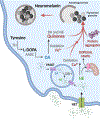Riddles in the dark: Decoding the relationship between neuromelanin and neurodegeneration in locus coeruleus neurons
- PMID: 37327835
- PMCID: PMC10523397
- DOI: 10.1016/j.neubiorev.2023.105287
Riddles in the dark: Decoding the relationship between neuromelanin and neurodegeneration in locus coeruleus neurons
Abstract
The noradrenergic locus coeruleus (LC) is among the first regions of the brain affected by pathology in both Alzheimer's disease (AD) and Parkinson's disease (PD), but the reasons for this selective vulnerability are not completely understood. Several features of LC neurons have been proposed as contributing factors to this dysfunction and degeneration, and this review will focus on the presence of neuromelanin (NM). NM is a dark pigment unique to catecholaminergic cells that is formed of norepinephrine (NE) and dopamine (DA) metabolites, heavy metals, protein aggregates, and oxidated lipids. We cover what is currently known about NM and the limitations of historical approaches, then discuss the new human tyrosinase (hTyr) model of NM production in rodent catecholamine cells in vivo that offers unique opportunities for studying its neurobiology, neurotoxicity, and potential of NM-based therapeutics for treating neurodegenerative disease.
Keywords: Alzheimer’s disease; Dopamine; Locus coeruleus; Neuromelanin; Norepinephrine; Parkinson’s disease; Tyrosinase.
Copyright © 2023 Elsevier Ltd. All rights reserved.
Figures


References
-
- Aston-Jones G, Cohen JD (2005) Adaptive gain and the role of the locus coeruleus-norepinephrine system in optimal performance. J Comp Neurol 493:99–110. - PubMed
-
- Braak H, Thal DR, Ghebremedhin E, Del Tredici K (2011) Stages of the pathologic process in Alzheimer disease: age categories from 1 to 100 years. J Neuropathol Exp Neurol 70:960–969. - PubMed
-
- Burke WJ, Li SW, Chung HD, Ruggiero DA, Kristal BS, Johnson EM, Lampe P, Kumar VB, Franko M, Williams EA, Zahm DS (2004) Neurotoxicity of MAO metabolites of catecholamine neurotransmitters: role in neurodegenerative diseases. Neurotoxicology 25:101–115. - PubMed
-
- Busch C, Bohl J, Ohm TG (1997) Spatial, temporal and numeric analysis of Alzheimer changes in the nucleus coeruleus. Neurobiol Aging 18:401–406. - PubMed
Publication types
MeSH terms
Substances
Grants and funding
LinkOut - more resources
Full Text Sources
Medical

